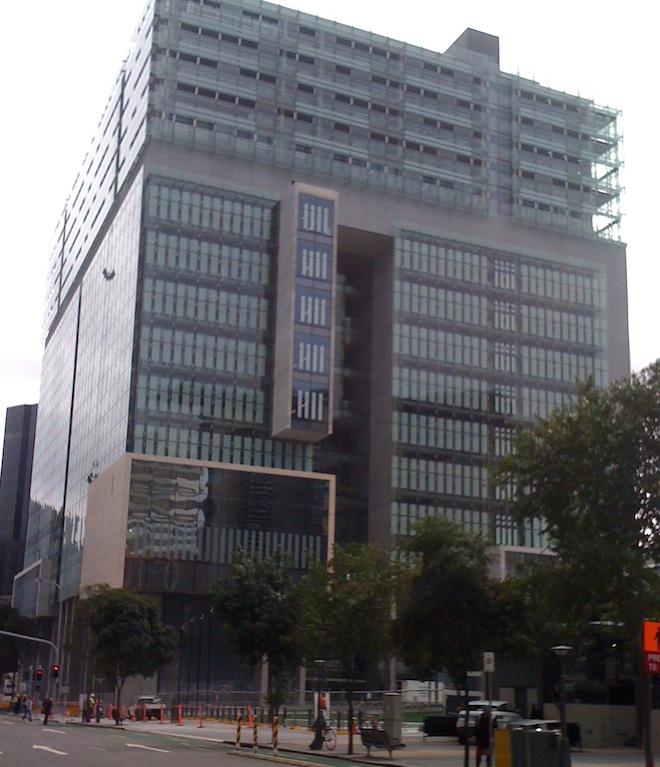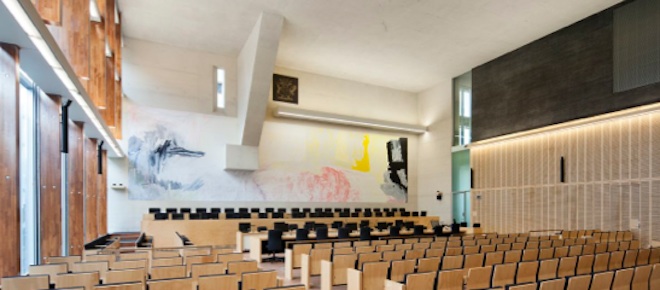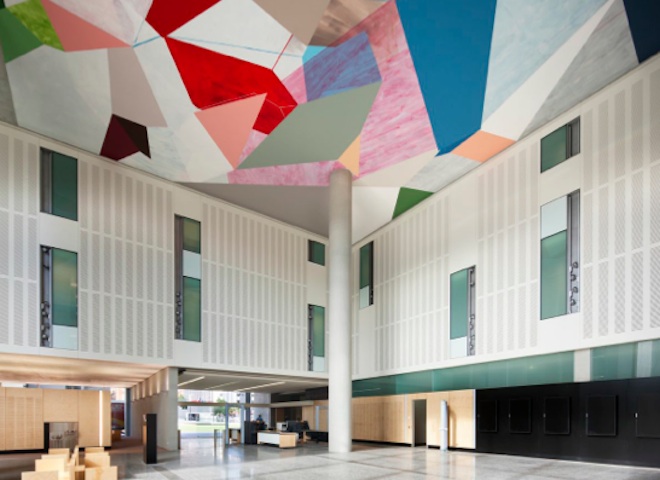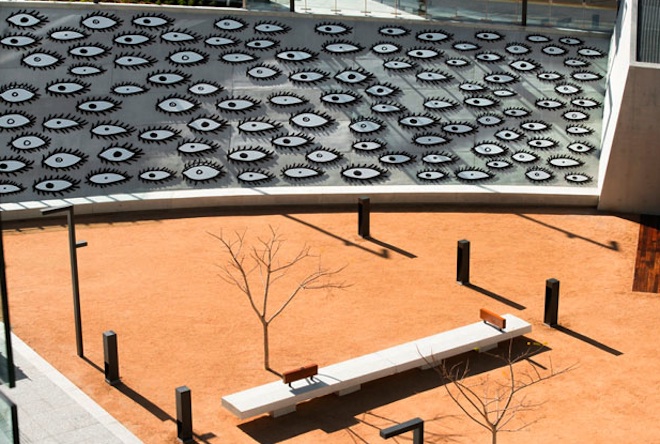Sir Terence O'Rort dismayed by the new, modern law courts in Brisbane ... Too way out for people of traditional values ... Puzzling artworks ... Punters and practitioners bewildered ... Massive judicial over-statement
 QE11 courthouse: industrial chic
QE11 courthouse: industrial chic
EVERY red-blooded Queensland bloke needs his own shed and our own Daphnis de Jersey CJ is no exception.
Daphnis has always been a bit flamboyant and his new shed, the Queen Elizabeth 11 Law Courts building, is no exception.
I hope that Liz and old Phil the Greek don't decide to make the journey to Oz to view the edifice.
With its exposed bare concrete ceilings and wooden tiled floors the courts are a tribute to post-modernist industrial chic and a nightmare for those poor punters and members of the Brisvegas legal game who have to use the building to eke out a miserable living.
The wooden tiles are a source of constant noise when parties or witnesses move about the building, particularly the female associates who, despite the gender equality war, do not all wear sensible flat shoes.
The carpeted courtrooms in the old courthouse may not have fulfilled the artistic fetishes of basket-weaving architects, but it made the lives of counsel, witnesses and court reporters a lot easier because you could actually hear what was said.
With their exposed concrete walls and ceilings every courtroom has an echo problem, which sometimes means the precious words of judges disappear into a vortex of reverberations.
At least now the crusty demons in the Court of Appeal can attribute any confusion that might arise on the hearing of appeals (Hanson, Fingleton and Patel) to their newly built environment.
It might soften the blow next time the High Court falls about laughing when consigning Qld appeal judgments to the dust bin.
Punters in the Banco Court gaze upon an Aboriginal art work, which covers an entire wall above the bench.
 Banco Court artwork: haunting
Banco Court artwork: haunting
In my humble opinion it is reminiscent of the floor of the public bar of the Alice Springs Hotel on a Saturday morning before the yardman has used the fire hose to remove evidence of a different kind of art work from the previous evening.
Not so according to John Gollings, the artist who finished the painting:
"This painting brings together four key, beloved places in Sally Gabori's life: the fig trees near the beach where several members of her family were born, including her mother, Mara, and her husband, Pat; the adjoining sea country where her big brother, Buddy, used to hunt for dugong and where her late warrior and hunter husband fought for women; the beach at Kalthuriy where her mother's father was born; the billabong at Nyinyilki with its casuarinas, its waterlilies and its unfailing supply of freshwater which people would scoop up in baler shells and trumpet shells.
The colours and shapes of these places are interwoven with memories of her life on Bentinck Island before white people came - of her big brother raising her after the death of her mother, of the hunting prowess of her brother, her father and her husband Pat, of fighting over women, and of the haunting songs which would be sung about kin who were off hunting or who had passed away."
Every floor has acres of open space, which could easily accommodate hundreds of tap-dancers on the wooden expanses, but it is the courtyard and foyer that take the cake.
Goodness knows how much money was lavished on the art work in the foyer. It is on the ceiling and anyone who has fainted after seeing their lawyer's tax invoice will be able to view it comfortably, while attended by paramedics.
 Foyer: connected, yet open
Foyer: connected, yet open
According to the Public Works Department blurb:
"The way that Gemma Smith unveils the elusive nature of space and viewpoint is fitting for the entryway of the courts. Smith's painting is not unlike the trompe l'oeil, popular in the Baroque period where a three dimensional optical illusion was painted directly onto the ceiling or wall - in this case the illusion is in abstract form.
In this artwork, suspended in an unexpected intuitive logic, a balance is created between structure and feeling. Her interlocking yet fragmented geometry contains both a sense of connectedness and openness."
The guiding hand of Daphnis can be seen in the public courtyard, which features an entire wall of "eyes", created by Japanese sculptor Yayoi Kusama - at unimaginable cost.
 Courtyard: surveillanceTo me they look like dead fish, but not according to the curator:
Courtyard: surveillanceTo me they look like dead fish, but not according to the curator:
"In a time when public accountability is of the utmost importance Kusama's eyes not only look back at you, they surround the courts with looking.
Metaphorically the process of justice is made transparent through the building's glass façade to the unblinking eyes, forever watching."
So if you don't mind the odd dead fish and are partial to dugong hunting among the water-lillies after a hard day of tap-dancing the new QEII Law Courts Building is just for you.
Sir Terence O'Rort reporting